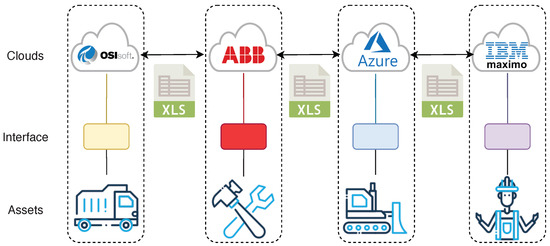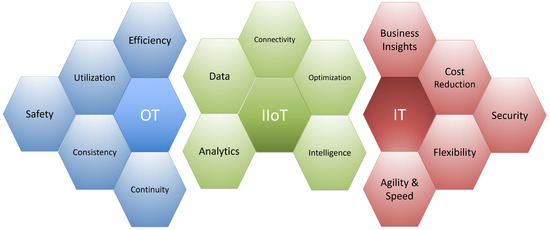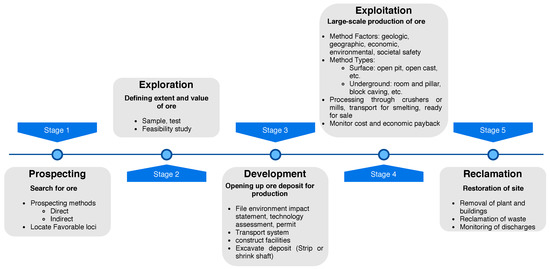The Industrial Internet of Things (IIoT) has the potential to improve the production and business processes by enabling the extraction of valuable information from industrial processes. The mining industry, however, is rather traditional and somewhat slow to change due to infrastructural limitations in communication, data management, storage, and exchange of information. Most research efforts so far on applying IIoT in the mining industry focus on specific concerns such as ventilation monitoring, accident analysis, fleet and personnel management, tailing dam monitoring, and pre-alarm system while an overall IIoT architecture suitable for the general conditions in the mining industry is still missing.
- IIoT
- mining industry
- industrial standards
- indus
Note: The following contents are extract from your paper. The entry will be online only after author check and submit it.
1. Introduction
The Internet of Things (IoT) is a technological paradigm imagined as a global network where devices or machines can interact [1]. IoT is acting as a technological revolution influencing all application domains including smart home, smart cities, agriculture, automobiles, health-care, industrial production, and transport [2][3][2,3]. It is estimated that there will be 50 to 100 billion smart things and objects connected to the Internet by 2020 [4][5][6][4,5,6]. In this context, industries are being challenged to rethink their production processes with the potential to spark innovations in production systems on an unprecedented scale [7].
The Industrial Internet of Things (IIoT), which is an application of IoT in industry, is part of the Industry 4.0 concept, which emphasizes the idea of consistent digitization and the connectivity of all productive units [8], combining the strengths of the traditional industry with internet technologies [9][10][9,10]. The Industrial Internet may also be considered as a convergence of Information Technology (IT) and Operational Technology (OT) as shown in Figure 1. IIoT is the network of physical objects, or things, embedded with electronics, sensors, and connectivity to enable that network to achieve greater value and service by exchanging data with the manufacturer, operator, and/or other connected devices [11]. Currently, many IoT technologies are integrated into consumer applications, such as smart homes, connected cars, and smart wearables. The industrial applications of IoT, or Industrial IoT (IIoT), however, are anticipated to have the capability to transform many industries, including manufacturing, oil and gas, agriculture, and mining [12].
Figure 1. Operational technology (OT) and information technology (IT) = Industrial Internet of Things (IIoT).
The scope of this research is the adoption of IIoT in the mining industry, specifically in the case of underground mining. The complexity and specific challenges in this industry include: heterogeneity where each mine has a different layout depending on the natural conditions, heavy transportation in combination with very confined spaces, wireless communication across shafts and stopes not possible, repeated blasting where devices would be destroyed unless moved every time, face drilling that changes the layout continuously, the need for fail-over and autonomous operations to ensure production and safety through catastrophic failures, etc. These challenges are further accentuated by the need for continuous production of large volumes of extracted ore to reached targeted goals set to ensure profitability in production. Other types of industries may be able to catch up after a stop in production, while in mining lost production can typically not be recovered by an increased phase of operations. The unique combination of these conditions is a motivation for the study. In particular, it is motivated by the complexity in terms of the need for flexible and adaptable IIoT systems to cope with the continuous change in topology and use of equipment and machines combined with the need to ensure production and safety although connectivity may occasionally fail.
2. Introduction to Mining: Stages in the Mining Life Cycle
In this section, we introduce the stages of the mining life cycle to show the operations in the mining industry. As shown in Figure 2, the overall sequence of activities in modern mining is often compared with the five stages in the life of a mine: prospecting, exploration, development, exploitation, and reclamation [13][23].
Figure 2. Stages in the mining lifecycle.
2.1. Prospecting
Prospecting, the first stage in the utilization of a mineral deposit is the search for ores or other valuable minerals (coal or nonmetallic). Because mineral deposits may be located either at or below the surface of the earth, both direct and indirect prospecting techniques are employed.
2.2. Exploration
The second stage in the life of a mine, exploration, determines as accurately as possible the size and value of a mineral deposit, utilizing techniques similar to but more refined than those used in prospecting.
2.3. Development
In the third stage, development, the work of opening a mineral deposit for exploration is performed. With it begins the actual mining of the deposit, now called the ore.
2.4. Exploitation
Exploitation, the fourth stage of mining, is associated with the actual recovery of minerals from the earth in quantity. Although development may continue the emphasis in the production stage is on production. Usually, only enough development is done before exploitation to ensure that production, once started, can continue uninterrupted throughout the life of the mine.
2.5. Reclamation
The final stage in the operation of most mines is reclamation, the process of closing a mine and re-contouring, re-vegetating, and restoring the water and land values. The best time to begin the reclamation process of a mine is before the first excavations are initiated. In other words, mine planning engineers should plan the mine so that the reclamation process is considered and the overall cost of mining plus reclamation is minimized, not just the cost of mining itself.
3. Industrial IoT Standardization and Related Initiatives
In this section, we cover relevant industrial reference architectures which are proposed by the standard bodies.
3.1. IIRA
Industrial Internet Reference Architecture (IIRA) [14] [24] started in 2014 and gives guidelines to construct industrial internet systems. It describes a standard open architecture framework that helps to design industrial internet systems with modern capabilities. It characterizes conventional architectural concerns and organizes them into the four viewpoints: business, usage, functional, and implementation. IIRA states that the functional domain is the most important part to consider for an IIoT system which describes five-layers as follows:
- Business layer: this layer provides the functions to allow end-to-end industrial operations such as work planning, scheduling, enterprise resource planning(ERP), and life cycle management.
- Application layer: it provides the functions to allow the execution of some task or goal by implementing the actual application logic such as application programming interface, and user interface, etc.
- Information layer: this layer offers functionalities to collect and store data and semantics, transforming and analyzing data, data provisioning, and deployment.
- Operations layer: this layer provides functions for assets to operate properly during the life-cycle. It is also responsible for asset deployment, configuration, diagnosis, and update.
- Control Layer: functions of this layer provides the control of industrial assets such as sensors, actuators, and communication.
3.2. RAMI 4.0
RAMI 4.0 is a three-dimensional six-layer architecture which is proposed by the German Plattform Industrie 4.0 and provides a service-oriented-architecture (SOA) framework for interoperability to assist and stimulate the main characteristics of industry 4.0. The main focus of RAMI 4.0 is the integration of industrial assets from the shop floor to the office floor with SOA-based services and applications in the manufacturing industry. It does not provide a detailed methodology of technical implementation but identifies the manufacturing industry standards that are analyzed in [15] [25]. The core specifications of RAMI 4.0 was published in [16] [26] and applied to the field of linked data in [17][27]. Both RAMI 4.0 and IIC’s IIRA provide reference architectures for industrial systems and the comparison of both architectures is published in the joint whitepaper [18][28].
3.3. oneM2M
oneM2M [19][20] [29,30] was formed in 2012 and it is an initiative of eight leading ICT standards organization: European Telecommunications Standards Institute (ETSI) from Europe; Association of Radio Industries and Businesses (ARIB) and Telecommunication Technology Committee (TTC) from Japan; China Communications Standards Association (CCSA) from China; Alliance for Telecommunications Industry Solutions (ATIS); Telecommunications Standards Development Society (TSDSI) from India and Telecommunications Industry Association (TIA) from the USA; and Telecommunications Technology Association (TTA) from Korea. The goal of oneM2M is to define a horizontal service layer [21][31] to provide a way to connect and communicate with different IoT systems. Different vendors offer IoT systems unable to inter-work with other IoT systems and forms vertical pipes causing fragmentation in the market. The oneM2M horizontal layered architecture [22] [32] addressing this problem by reducing the vertical fragmentation in the market [23][33]. A joint paper [24] [34] was written by IIC and oneM2M which maps the IIRA and oneM2M in detail and provides the future directions for both organizations.
3.4. Arrowhead Framework
The EU Arrowhead Project [25] [35] started in 2013 and proposed an architecture [26] [36] to describe the workflow of IoT-based automation. The proposed architecture and open-source framework is according to the guidelines of RAMI 4.0 [27][37]. The project is already underway in the context of the successors Productive 4.0 [28] [38] and Arrowhead Tools [29] [39] projects. These projects continue the work on the Arrowhead Framework [30] [40] aiming to facilitate the development, deployment, and orchestration of integrated systems based on the SOA concept in an appropriate manner. The Arrowhead Framework forms SOA based Local clouds with three mandatory core systems which are Service Registry, Authorization, and Orchestration system. To enhance the capabilities of the Arrowhead Local Clouds, there are several supporting systems and services are available such as EventHandler, Gateway, Gatekeeper, QoS managing, and monitoring system and many are under development for the future. The further work on Arrowhead Framework is done in the Eclipse Arrowhead project [31][41].
4. Current IT Practices in Mining Industry and Key Challenges
In this section, we describe the current IT practices after studying the IT infrastructure in the mining companies. Though not under the term IIoT, the mining companies have been deploying programmable logic controller (PLC) and supervisory control and data acquisition (SCADA) systems for monitoring and controlling for decades e.g., there exists a number of commercially available systems. Compared with IIoT systems, these existing monitoring and control systems are generally proprietary systems and were not designed to interoperate or interconnect with other systems. The major difference between IIoT-based systems and legacy systems is that IIoT systems are based on an open, highly connected Internet Protocol (IP) network structure.
Currently, the mining industry is highly dependant on commercial systems and applications which causes vertical fragmentation. Exploration is the starting point where geologists take samples from specific locations and test in the laboratory. These samples are then analyzed based on various factors such as the size of holes and materials extracted from the holes. After analyzing the samples, geologists create Geo-statistical models. This department of exploration has its own tools and software. The final results are then handed over to the planning department. Planning departments also have their own set of software and tools to make plans based on the input from exploration results. The problem here is that the exploration department export results in an excel sheet to share with the planning department where the results can be only import from the excel sheet because there is no communication established between these systems. Similarly, the further processes are also acting as independent and have no integration with each other such as rock mechanics, drilling and blast, load and haul, crushers, stockpiles, mills for processing, and concentration. Finally, the material is stored in the warehouses and the sales department needs to sell and manage the records.
These various departments based on different stages of the mine life are using different IT systems design and developed by different vendors. The popular commercial systems in the industry are ABB, OSIsoft, IBM Maximo, Microsoft Azure, Dynamics 365, and Power BI. IBM Maximo offers solutions for asset management, ABB provides the production solutions and popular within control systems. Some IoT devices are attached to ABB systems, which carry vital information. The OSIsoft is trying to get data from various systems to integrate, but most of the data are integrated via excel sheets. The analytics and machine learning components are also needed for better operations and benefits for the mining industry. For analytics Microsoft Azure is in use which gets data from the data lake, OSIsoft, ABB by importing excel sheets.
As shown in Figure 3, all these systems, and applications are not able to interoperate. These commercial systems have their individual technology stack and data formats, hence one system can interoperate with another system of the same provider but unable to interoperate with a different provider. This causes a big hurdle for applying industrial internet paradigms in the mining industry and slows production.

Figure 3. Vertical silos in each domain of mining.
There are various challenges to achieve interoperability and communication between different systems in the mining industry. As shown in Figure 3 the current state of the systems in the mining industry is as vertical pipes. The mining industry is facing various key challenges which are summarized as follows:
-
Technological Variety: the development of IIoT based system is based on five main technologies: wireless sensor network (WSN), radio frequency identification (RFID), cloud computing, middleware/gateways, and IIoT application software [1]. Moreover, there are various already deployed systems that are based on a different set of technologies.
-
Possession of data: the matter of data possession or the ownership of data is an important challenge not only in the mining industry but across many other industries. Industries usually tend to keep the data as well as the information to interpret the data. The owner is typically the one who generates the data, but the system provider collects the data from various customers and can identify the trends by analyzing it.
-
Data distribution between legacy systems: in the mining industry, data is distributed across different legacy platforms and systems that causing problems to gather the information for analytics and further operations.
-
Security: IIoT enables various systems and applications to communicate with each other and open up various security threats. The communication channels should be secure, IIoT devices become more vulnerable to various attacks such as DDoS. Moreover, the rules for data governance and specific security planning is needed.
-
Data Management: In the IIoT environment, devices and assets produce data which then store into the central data layer which later use by analytics applications. There are various data sources in the mining industry such as Enterprise Resource Planning (ERP) system, PIMS, Manufacturing Execution Systems (MES), and many legacies IT systems. In this scenario, data management is a challenging task that requires the use of data lakes, migration, master data, and replication. This challenge becomes worst when there are different cloud providers involved, which is the typical case in the mining industry.
-
Analytics: the analytics in the mining industry have added importance compared to the other industries because of the heavy machinery, human force, mill functions, and stockpiles. The operation managers need better insights into the processes and machines, so they can detect issues and act accordingly. There is also a need for edge analytics at the mine sites which targets mostly the operations, but analytics also needs on the office floor for business trends and needs.


